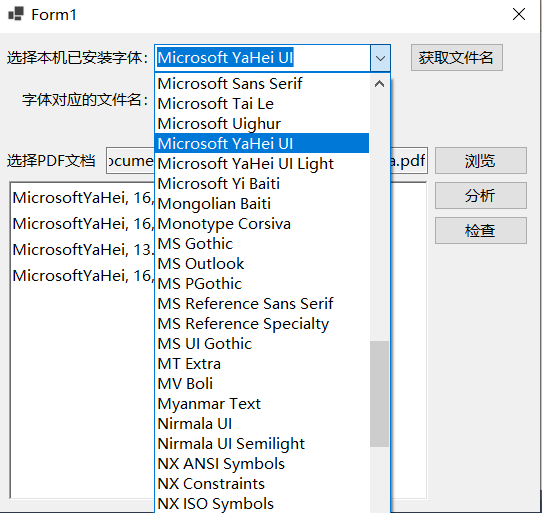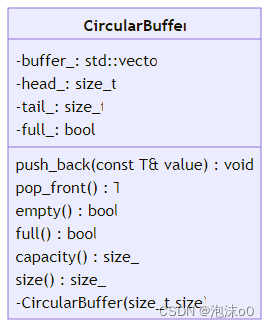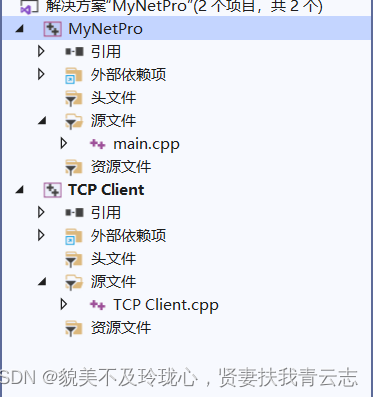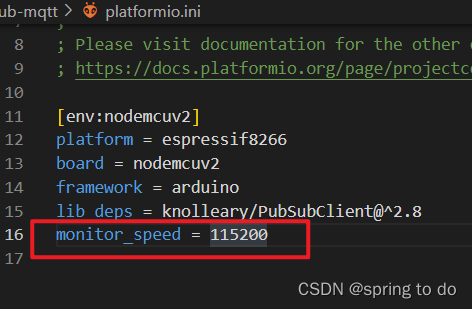第4章 Container
reference 引用
Declaring references
Reference is a new way to manipulate objects in C++
– char c; // a character
– char* p = &c; // a pointer to a character
– char &r = c; // a reference to a character
区分指针*:
`int* p = &c; //标点,不参与计算,表示作用
*p = c;` //运算符,参与计算,计算后有结果
同理区分引用&
– char* p = &c; // 运算符,取c的地址
– char& r = c; // 标点,表示r是引用类型。等号右边必须是变量,而不是常量(变量的值,只能被读取,不能被写入)。r表示c的别名
int main(){char c = 'A';char& r = c;r = 'B';cout << "c:" << c << endl;cout << "r:" << r << endl;c = 'C';cout << "c:" << c << endl;cout << "r:" << r << endl;}/*输出c: Br: Bc: Cr: C*/
• Local or global variables
– type& refname = name;
– For ordinary variables, the initial value is required
• In parameter lists and member variables
– type& refname
– Binding defined by caller or constructor
References
• Declares a new name for an existing object
int X = 47;
int& Y = X; // Y is a reference to X
// X and Y now refer to the same variable
cout << "Y = " << y; // prints Y = 47
Y = 18;
cout << "X = " << x; // prints X = 18
Rules of references
• References must be initialized when defined
• Initialization establishes a binding
• In declaration
int x = 3;
int& y = x;
const int& z = x; z不能被修改,x可以被修改
• As a function argument
void f ( int& x ); f(y); // initialized when function is calledvoid f(int& x){x++;cout << "in f() x = " << x << endl;}int main(){int a = 51;cout << "b4 f() a =" << a << endl;f(a);cout << "after f() a =" << a << endl;}/*输出:b4 f() a = 51in f() x = 52after f() a = 52把a传入后,x就是a的别名,对x操作就是对a操作,所以a的值会发生变化*/
const作用:
void f(const int& x){x++;cout << "in f() x = " << x << endl;}
int main(){int a = 51;cout << "b4 f() a =" << a << endl;f(a);cout << "after f() a =" << a << endl;
}
//编译后会错误,不能给x++,因为x是const,不能被修改
• Bindings don’t change at run time, unlike pointers
• Assignment changes the object referred-to
int& y = x;
y = 12; // Changes value of x
• The target of a reference must have a location!
void func(int &x);
func (i * 3); // Warning or error!
因为i * 3结果是右值,不能赋给左值x
void f(int& x){x++;cout << "in f() x = " << x << endl;}
int main(){int a = 51;cout << "b4 f() a =" << a << endl;f(a + 2);cout << "after f() a =" << a << endl;
}/*
f(a+2)不能传给void f(int& x),会编译错误
如果改成void f(int x)可以编译通过
*/
Pointers vs. References
References
• can’t be null
• are dependent on an existing variable, they are an alias(别名) for an variable
• can’t change to a new “address” location
• Pointers
– can be set to null
– pointer is independent of existing objects
– can change to point to a different address
Restrictions
• No references to references 没有引用的引用
• No pointers to references 没有指向引用的指针
int&* p; // illegal *号离p近说明是指针
– Reference to pointer is ok 指针的引用可以
void f(int*& p);
• No arrays of references没有引用的数组
Container
A personal notebook
• It allows notes to be stored.
• It has no limit on the number of notes it can
store.
• It will show individual notes.
• It will tell us how many notes it is currently
storing.
Collection
• Collection objects are objects that can store an
arbitrary number of other objects.
What is STL
• STL = Standard Template Library
• Part of the ISO Standard C++ Library
• Data Structures and algorithms for C++.
Why should I use STL?
• Reduce development time.
–Data-structures already written and debugged.
• Code readability
–Fit more meaningful stuff(东西) on one page.
• Robustness 健壮性
–STL data structures grow automatically.
• Portable code. 可移植性
• Maintainable code 可维护代码
• Easy
C++ Standard Library
• Library includes:
–A Pair class (pairs of anything, int/int, int/char, etc)
–Containers
• Vector (expandable array) 扩展数组
• Deque (expandable array, expands at both ends)
• List (double-linked)
• Sets and Maps
–Basic Algorithms (sort, search, etc)
• All identifiers in library are in std namespace :
using namespace std;
The three parts of STL
• Containers
• Algorithms
• Iterators
The ‘Top 3’ data structures
• map
–Any key type, any value type.
–Sorted.
• vector
–Like c array, but auto-extending.
• list
–doubly-linked list
All Sequential Containers
• vector: variable array
• deque: dual-end queue
• list: double-linked-list
• forward_list: as it
• array: as “array”
• string: char. array
Example using the vector class
#include <iostream>#include <vector>//Use “namespace std” so that you can refer to vectors in C++ libraryusing namespace std;int main(){//Declare a vector of ints(no need to worry about size)vector<int> x;//Add elementsfor(int a = 0; a < 1000; a++){a.push_back(a);}//Have a pre-defined iterator for vector,can use it to print out thr items in vectorvector<int>::iterator p;for(p = x.begin(); p < x.end(); p++){cout << *p << " ";//能用*因为重载了*运算符}return 0;}#include <iostream>#include <vector>//Use “namespace std” so that you can refer to vectors in C++ libraryusing namespace std;int main(){vector<int> x;for(int i = 0; i < 100; i++){x.push_back(i);}for(auto i: x){cout << i << " ";}return 0;}
generic classes泛型类
vector notes;
• Have to specify two types: the type of the collection itself (here: vector) and the type of the elements that we plan to store in the collection
(here: string)
vector
• It is able to increase its internal capacity as required: as more items are added, it simply makes enough room for them.
• It keeps its own private count of how many items it is currently storing. Its size method returns the number of objects currently stored in it.
• It maintains the order of items you insert into it. You can later retrieve them in the same order.
Basic Vector Operations
• Constructors
vector c;
vector c1(c2); 用c2创建c1
• Simple Methods
V.size( ) // num items
V.empty( ) // empty?
==, !=, <, >, <=, >=
V.swap(v2) // swap
• Iterators
I.begin( ) // first position
I.end( ) // last position
• Element access
V.at(index)
V[index]
V.front( ) // first item
V.back( ) // last item
//可以这么遍历
for(int i = 0; i < x.size(); i++){cout << x[i] << " ";
}
• Add/Remove/Find
V.push_back(e)
V.pop_back( )
v.insert(pos, e)
V.erase(pos)
V.clear( )
V.find(first, last, item)
Two ways to use Vector
Preallocate
vector<int> v(130);//
v[80] = 1;//ok
v[200] = 1;//bad
Grow tail
vector<int> v2;
int i;
while(cin >> i){v.push_back(i);
}
List Class
• Same basic concepts as vector
–Constructors
–Ability to compare lists (==, !=, <, <=, >, >=)
–Ability to access front and back of list
x.front(), x.back()
–Ability to assign items to a list, remove items
x.push_back(item)
x.push_front(item)
x.pop_back()
x.pop_front()
x.remove(item)
Sample List Application
#include <iostream>
#include <list>
#include <string>
using namespace std;int main(){//Declare a list of stringslist<string> s;s.push_back("hello");s.push_back("world");s.push_front("tide");s.push_front("crimson");s.push_front("alabama");list<string>::iterator p;for(p = s.begin(); p != s.end(); p++){cout << *p << " ";}cout << endl;
}
/*
输出:
alabama crimson tide hello worldNote the termination condition for our iterator p != s.end( )
–Cannot use p < s.end( ) as with vectors, as the list elements may not be stored in order
*/
Example of Lists
list<int> L;
for(int i = 1; i <= 5; i ++){L.push_back(i);
}
//delete second item
L.erase(++L.begin());
copy(L.begin(), L.end(), ostream_iterator<int>(cout, ","));//Prints:1, 2, 3, 5
Maintaining an ordered list
#include <iostream>#include <list>#include <string>using namespace std;int main(){list<string> s;string t;list<string>::iterator p;for(int a = 0; a < 5; a++){cout << "enter a string:" ;cin >> t;p = s.begin();while(p != s.end() && *p < t){p++;}s.insert(p, t);}for(p = s.begin(); p != s.end(); p++){cout << *p << " ";}cout << endl;}
Maps
• Maps are collections that contain pairs of values.
• Pairs consist of a key and a value.
• Lookup works by supplying a key, and
retrieving a value.
• An example: a telephone book
Example Map Program
#include <map>#include <string>map<string, float> price;price{"snapple"} = 0.75;price{"coke"} = 0.50;string item;double total = 0;while(cin >> item){total += price{item};}
Simple Example of Map
map<long, int> root;
root[4] = 2;
root[1000000] = 1000;
long l;
cin >> l;
if(root.count(l)){//如果在映射容器中存在带有键K的元素,则该函数返回1。如果容器中不存在键为K的元素,则返回0cout << root[l];
}else{cout << "Not perfect square";
}
Iterator
• Declaring
list::iterator li;
• Front of container
list L;
li = L.begin();
• Past the end
li = L.end();
• Can increment
list::iterator li;
list L;
li=L.begin();
++li; // Second thing;
• Can be dereferenced
*li = 10;
Algorithms
• Take iterators as arguments
list<int> L;
vector<int> V;
// put list in vector
copy( L.begin(), L.end(), V.begin() )
List Example Again
list<int> L;
for(int i=1; i<=5; ++i)L.push_back(i);
//delete second item.
L.erase( ++L.begin() );
copy( L.begin(). L.end(),ostream_iterator<int>(cout, “,"));
// Prints: 1,2,3,5
for-each loop
A for-each loop iterates over the elements of arrays,vectors,or any other data sets.It assigns the value of the current element to the variable iterator declared inside the loop
for(type variable_name array/vector_name){loop statements
···
}
for-each循环,不能修改值,只能读取值
Example of for-each
#include<iostream>using namespace std;int main()int arr[]=(1,2,3,4,5);//array initializationcout<<"The elements are:"for(int i arr){//autocout << i << " ";}return 0;}#include<iostream>#include<vector>using namespace std;int main(】vector<int>vec=(11,22,33,44,S5,66}:cout<<"The elements are:"for(auto var: vec){cout << var << " ";}return 0;}
Pros and Cons 利弊
Advantages of foreach loop
o It eliminates the possibility of errors and makes the code more readable.
o Easy to implement
o Does not require pre-initialization of the iterator
Disadvantages of foreach loop
o Cannot directly access the corresponding element indices
o Cannot traverse the elements in reverse order
o It doesn’t allow the user to skip any element as it traverses over each one of them
Using your own classes in STL Containers
• Might need:
–Assignment Operator, operator=()
–Default Constructor
• For sorted types, like map<>
–Need less-than operator: operator<()
• Some types have this by default:
–int, char, string
• Some do not:
–char *
The type in containers
What’s the difference?
vectorv1;
vector<Student&>v2;
vector<Student*>v3;
Pitfalls 陷阱/隐患
• Accessing an invalid vector<> element.
vector v;
v[100]=1; // Whoops!
Solutions:
–use push_back()
–Preallocate with constructor.
–Reallocate with reserve()
–Check capacity()
• Inadvertently inserting into map<>.
if (foo[”bob”]==1) //silently created entry “bob”
Use count() to check for a key without creating a new entry.
if ( foo.count(“bob”) )
• Not using empty() on list<> .
–Slow
if ( my_list.count() == 0 ) { … }
–Fast
if ( my_list.empty() ) {…}
• Using invalid iterator
list<int> L;
list<int>::iterator li;
li = L.begin();
L.erase(li);
++li; // WRONG
• Use return value of erase to advance
li = L.erase(li); // RIGHT






